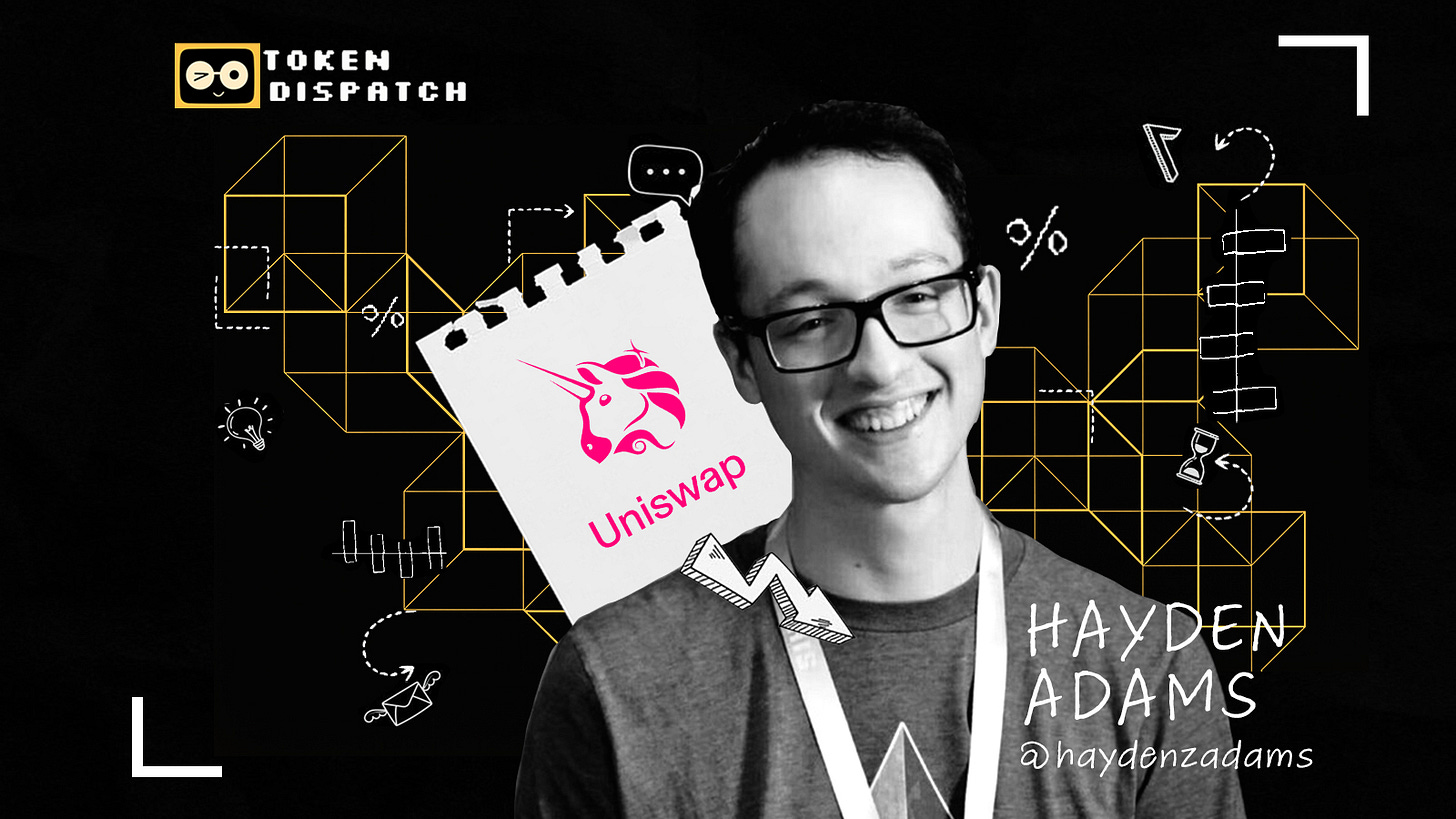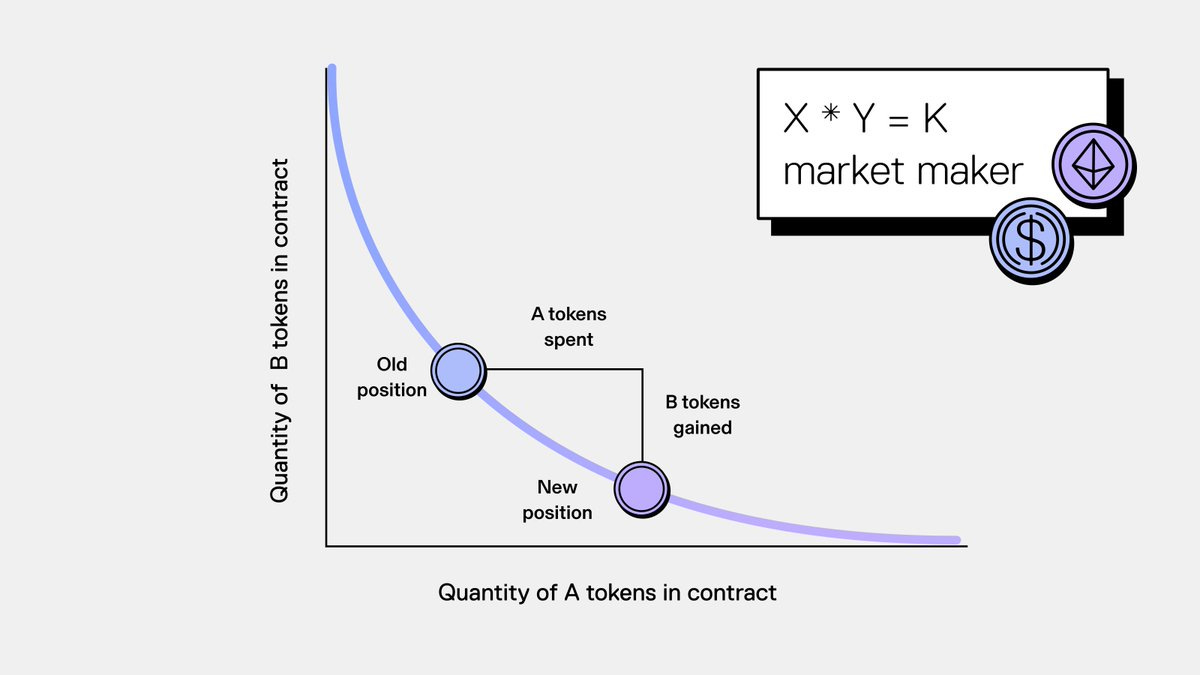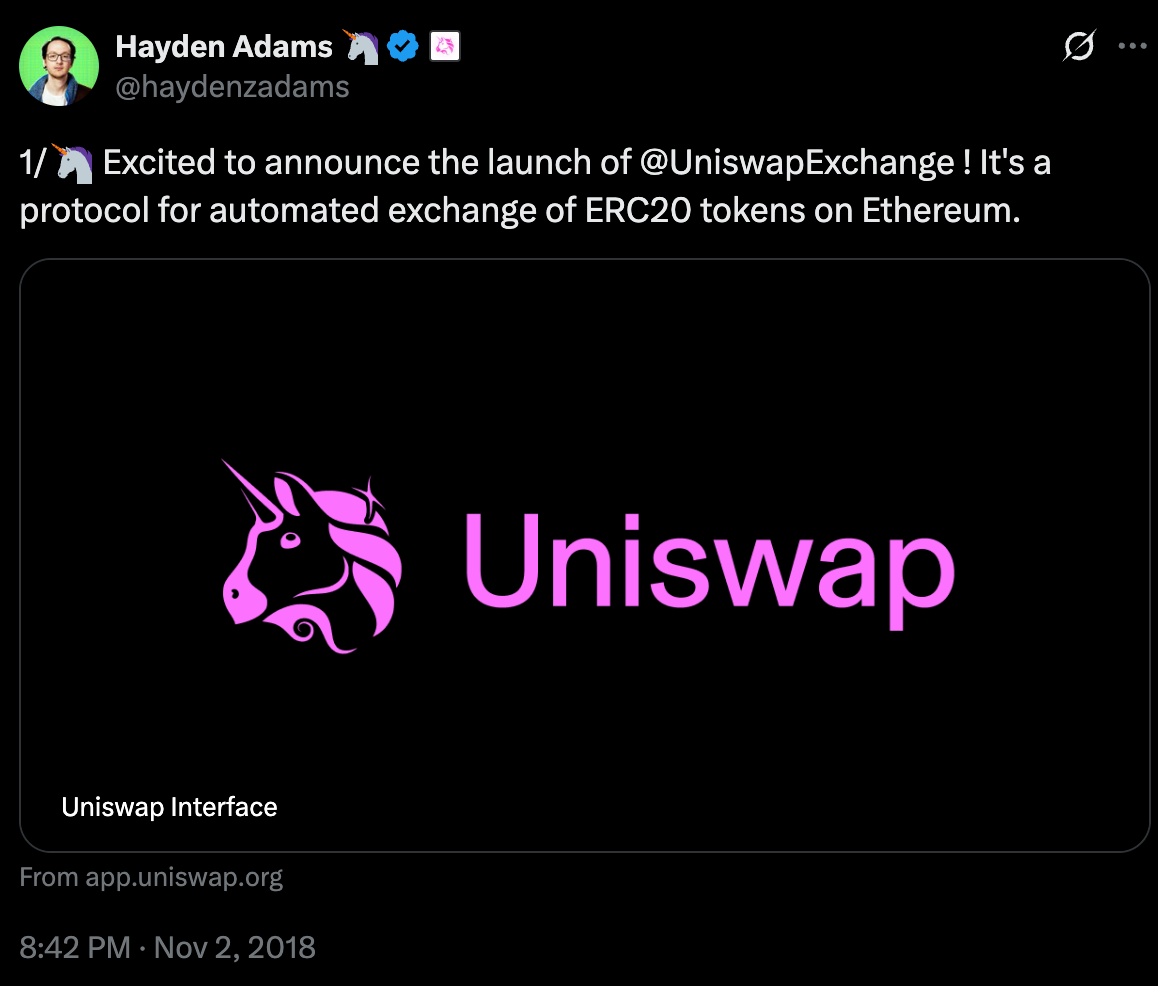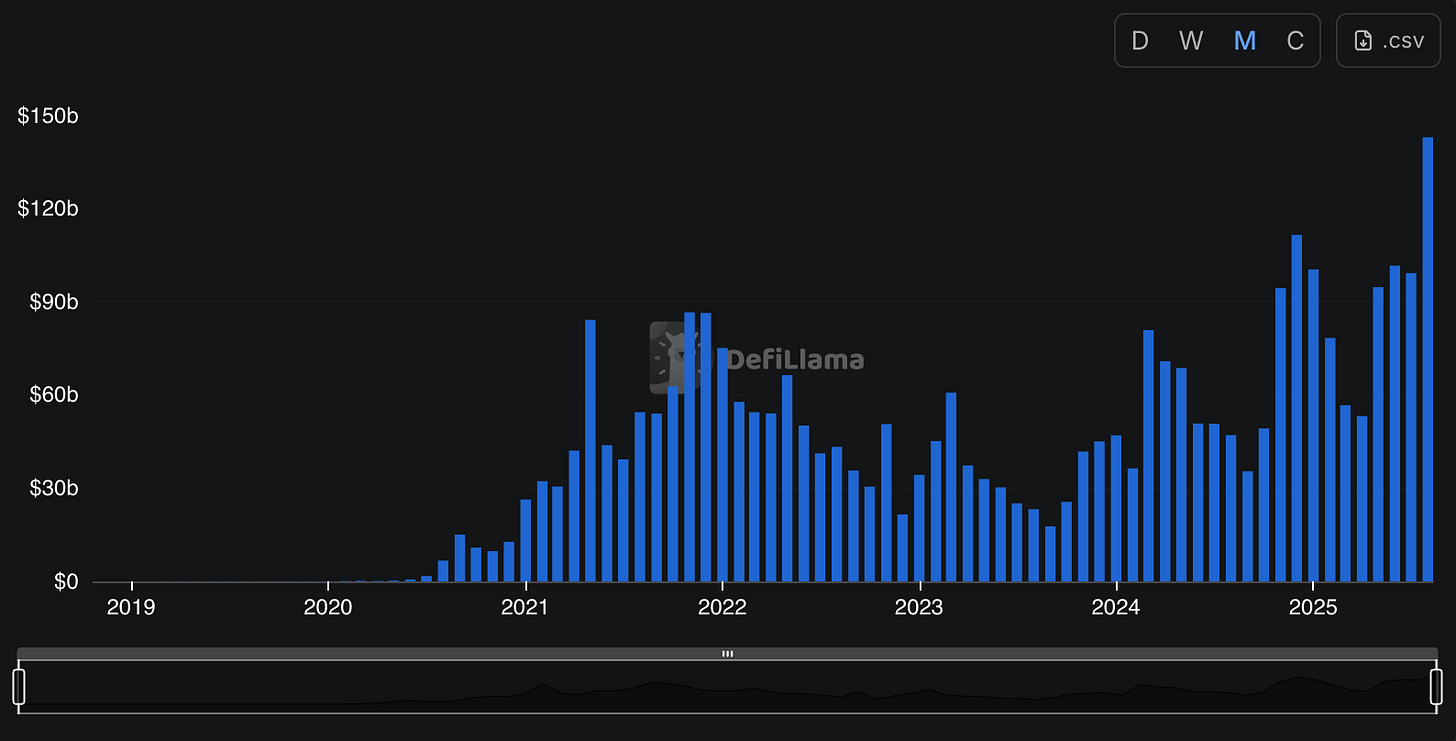Hayden Adams: The Uniswap Story 🦄
The crypto visionary who changed how the world trades digital assets
July 6, 2017. The call comes from HR.
Hayden Adams is being laid off from Siemens after one year as a mechanical engineer. The heat flow simulation work never felt like a good fit. Adams wasn't thriving in the role. The company was making cuts.
24-year-old Adams felt nothing but relief.
He had been struggling with deciding whether engineering was the right career path. The layoff forced a decision he had been avoiding.
His phone buzzes. A text from his college roommate.
Karl Floersch works at something called the Ethereum Foundation. For years, he's been preaching about blockchain technology. Smart contracts. Decentralised applications. Revolutionary stuff.
Adams always tuned him out. Too abstract and weird.
Now, unemployed and uncertain, he decides to listen.
The phone call lasted three hours. Floersch painted a picture of the future. Code that runs without human oversight. Money that moves without banks. Applications that serve millions without corporate control.
The conversation that followed plants the seed for what will become Uniswap.
But first, he needed to convince himself that pivoting from mechanical engineering to cryptocurrency made sense.
Turn Bitcoin Mining Into Passive Income, Without The Hassle.
With Abundant Mines, you purchase mining hardware and their team handles everything else: setup, maintenance, repairs, and monitoring. You simply collect steady Bitcoin payouts straight to your wallet.
Start with as little as $10k (including hardware and first-year energy costs)
Guaranteed 95–99% uptime with expert on-site care
Powered by low-cost hydroelectric energy for consistent, affordable operation
Enjoy powerful tax advantages like 100% first-year equipment depreciation
Projected returns: 30–50% per year if Bitcoin price holds steady
No tech skills required, just invest and earn.
👉Start mining the smart way
The Ethereum Evangelist
Floersch saw opportunity where Adams saw uncertainty.
Ethereum was young enough that someone motivated can become an expert in months. The barriers were low because few people understood the technology.
Adams had concerns. He had no coding background beyond basic coursework. He's never built a website or written a smart contract. The prospect of pivoting from mechanical engineering to software development felt daunting.
Floersch offered a framework: learn by building something real. Instead of taking online courses, Adams should pick a specific project and work toward shipping it. The learning will happen naturally through the process of creation.
Floersch explained how Ethereum worked, why decentralised applications matterred, what problems needed solving. He described an emerging ecosystem where small teams can build products serving millions of users without traditional corporate infrastructure.
Adams found himself getting interested despite his skepticism.
He made a decision. He'll spend the next year learning to code and building something meaningful on Ethereum. The conversation ended with Adams feeling cautiously optimistic.
The Basement Laboratory
Adams moved back into his childhood bedroom in the New York suburbs.
His parents tried to be supportive. Their son studied mechanical engineering at Stony Brook University. He worked at a prestigious company. Now he wants to learn programming to build applications on something called a blockchain.
The learning curve is steep. Adams watched YouTube tutorials about JavaScript. He read documentation about Solidity, Ethereum's programming language. Concepts that seem intuitive to computer science graduates require intense study for someone from the physical engineering world. He approached coding like any engineering problem. Each function served a purpose within a larger system. Every variable had meaning. Smart contracts are machines that transform inputs into outputs according to predetermined rules.
Progress came slowly. Adams built simple contracts that store and retrieve data. He learnt to deploy code to Ethereum's test networks. The gap between abstract concepts and practical implementation narrowed with each small success.
Floersch visited regularly, offering guidance and encouragement. During one visit in late 2017, he presented Adams with a specific challenge.
Vitalik Buterin, Ethereum's co-founder, has written blog posts about automated market makers. The concept described a new way to facilitate trading without traditional order books. Instead of matching buy and sell orders, traders would interact with pools of liquidity governed by mathematical formulas.
No one has built a working implementation yet.
Adams studied the concept. Market making involves complex systems with multiple participants, precise calculations, and real-time responsiveness. The problem combines mathematical theory with practical engineering in ways that intrigue him.
Floersch made an offer. Build a working prototype with a user interface in one month, and he'll showcase it during his upcoming talk at Devcon, Ethereum's flagship conference.
Adams accepted the challenge. He has thirty days to learn web development, implement automated market maker logic, and create something worth demonstrating to the global Ethereum community.
The Protocol That Changed Everything
November 2, 2018. Adams prepared to deploy his smart contracts to Ethereum's mainnet.
The journey from prototype to production took over a year. What started as Floersch's one-month challenge grew into a comprehensive protocol with multiple iterations. The initial demo at Devcon 2 proved the concept worked. But Adams wanted to build something robust enough for real users with real money. The process involved rewriting smart contracts, conducting security audits, and refining the user interface. Each improvement brought the system closer to production readiness.
Buterin suggested rewriting the contracts in Vyper, a different programming language. He recommended applying for an Ethereum Foundation grant. The grant application process forced Adams to articulate his vision clearly.
The $65,000 grant provided a runway to work full-time on the project. Adams used the funding to audit the smart contracts, build a production-ready interface, and prepare for mainnet launch. Every detail mattered because users would be trusting the system with real money.
The mathematical formula at Uniswap's core is x * y = k.
This constant product formula ensures that the product of two token quantities in a liquidity pool remains constant during trades. As one token becomes scarce, its price increases proportionally.
Adams deployed the contracts during Devcon 4 in Prague. Launching at Ethereum's biggest conference will maximise visibility among developers and early adopters. He announced the deployment on Twitter to his roughly 200 followers.
The early response were mixed. Some developers praised the elegant design and permissionless architecture. Others questioned whether automated market making can compete with traditional centralised exchanges. Trading volumes in the first weeks are modest, limited to curious developers and DeFi enthusiasts.
Adams anticipated the skepticism. Uniswap was not designed to be more efficient than centralised exchanges. Instead, it offers trustless trading without intermediaries, permissionless token listing, and composable liquidity that other applications can build upon. Centralised exchanges depend on market makers to actively participate in markets and adjust liquidity whenever the price moves. AMMs flip the model to automate the market-making function. This means you no longer need market makers. Once you deploy a pool, pool logic takes care of market making.
Tokens can be created without anybody’s permission. So, as new tokens launched on Ethereum, their should be permissionless ways to trade them. Centralised exchanges charge high listing fees and require lengthy approval processes. Uniswap allows anyone to create a market by depositing tokens and earning fees from subsequent trades.
By early 2019, daily trading volume grew consistently. The protocol processed millions of dollars in trades while requiring no employees, offices, or traditional business operations. Adams built a system that operates according to mathematical rules rather than human decision-making.
The summer of 2020 changed something for decentralised finance.
DeFi Summer brought explosive growth to blockchain-based financial applications. Uniswap sat at the centre of the movement, providing infrastructure that enables new forms of programmable money.
Adams watched trading volumes surge from millions to billions of dollars per month. The protocol processed more volume than many traditional financial institutions while remaining decentralised and permissionless.
The success attracted venture capital attention. Adams founded Uniswap Labs to formalise the team and accept institutional investment. The company raised $11 million in Series A funding led by Andreessen Horowitz, providing resources to accelerate development.
Version 2 launched in May 2020 with significant improvements. The new contracts support direct trading between any ERC-20 tokens, not just trades paired with Ethereum. They include price oracles that other protocols can use for various applications. Flash loans allowed users to borrow tokens temporarily within a single transaction.
The innovations enabled use cases Adams had not anticipated. Other developers built lending protocols, derivatives platforms, and yield farming strategies on top of Uniswap's infrastructure. The protocol became a composable infrastructure that amplifies innovation across the entire DeFi ecosystem.
September 2020 brought another milestone with the UNI governance token launch. Adams and his team distributed 400 tokens to every address that had ever used Uniswap, creating one of the largest airdrops in crypto history. The retroactive distribution rewarded early users and aligns their interests with the protocol's long-term success.
Version 3, launched in May 2021, introduced concentrated liquidity. Liquidity providers can focus their capital within specific price ranges, improving capital efficiency by up to 4,000 times for certain strategies. The innovation attracted professional market makers while maintaining accessibility for individual users.
The concentrated liquidity feature fundamentally changed how market makers operate on Uniswap. Previously, liquidity was spread across all possible price ranges, leading to capital inefficiency. With V3, providers could define precise ranges where they wanted to provide liquidity. This allowed for more strategic positioning and better risk management. Liquidity providers could set stop-loss mechanisms on impermanent loss by concentrating their positions within expected trading ranges, making the market more sophisticated and professional.
Uniswap V3 attracted both professional market makers seeking advanced strategies and individual users benefitting from greater accessibility and capital efficiency.
Each iteration expands Uniswap's capabilities while preserving its core principles. The protocol remains permissionless, trustless, and resistant to censorship. Anyone can trade any token without providing personal information or seeking approval from intermediaries.
Adams built what traditional finance considered impossible. A fully automated exchange that operates without human oversight while handling billions of dollars in daily volume.
October 10, 2024. Uniswap Labs announced Unichain, an Ethereum Layer 2 network designed specifically for DeFi applications.
The blockchain represents Adams' evolution from protocol developer to infrastructure provider. Building a dedicated network allows Uniswap to optimise the entire stack for automated market making.
Unichain launched on February 11, 2025, with Rollup-Boost technology. Trusted execution environments enable private mempools and fair transaction ordering. This technical innovation addressed a persistent problem in decentralised trading: maximal extractable value, or MEV.
In traditional blockchain networks, sophisticated traders can observe pending transactions and front-run regular users by paying higher gas fees. This practice extracts value from ordinary traders, making their trades more expensive. Unichain's private mempools hide transaction details until they're processed, while trusted execution environments ensure transactions are ordered fairly based on when they arrive, not how much users pay in fees.
The network processes transactions in 200-millisecond sub-blocks. The speed improvement makes Uniswap competitive with centralised exchanges for latency-sensitive trading strategies. These technical advances reduce the value that sophisticated traders can extract from regular users, creating a fairer trading environment.
Today, Uniswap processes over $2-$3 billion in daily trading volume across multiple blockchain networks. Version 4, launched in 2025, introduces hooks that allow developers to customise pool behaviour for specific use cases. The protocol continues evolving while maintaining the simplicity and accessibility that made it revolutionary.
Adams remains focused on his original mission of making value exchange as simple and accessible as information exchange.
From a childhood bedroom to billions in daily volume, Uniswap proves that decentralised systems can compete with traditional institutions.
That’s it about the Uniswap guy. Will come to you with another profile next week.
Until then …stay curious.
Token Dispatch is a daily crypto newsletter handpicked and crafted with love by human bots. If you want to reach out to 200,000+ subscriber community of the Token Dispatch, you can explore the partnership opportunities with us 🙌
📩 Fill out this form to submit your details and book a meeting with us directly.
Disclaimer: This newsletter contains analysis and opinions of the author. Content is for informational purposes only, not financial advice. Trading crypto involves substantial risk - your capital is at risk. Do your own research.









